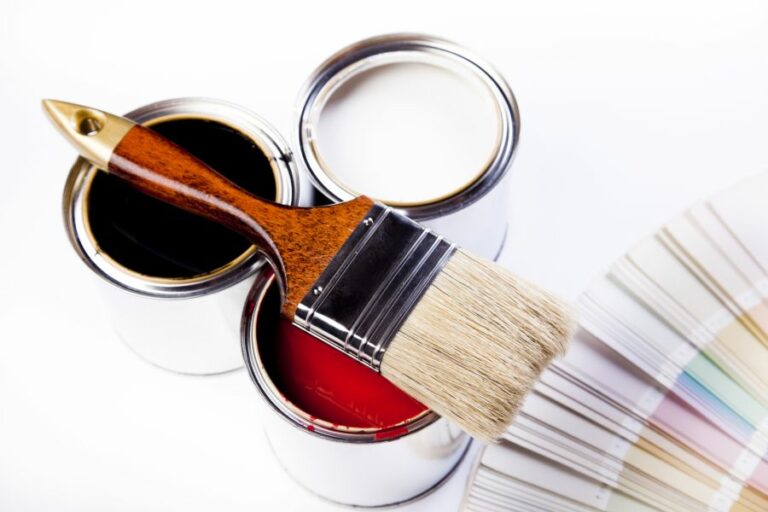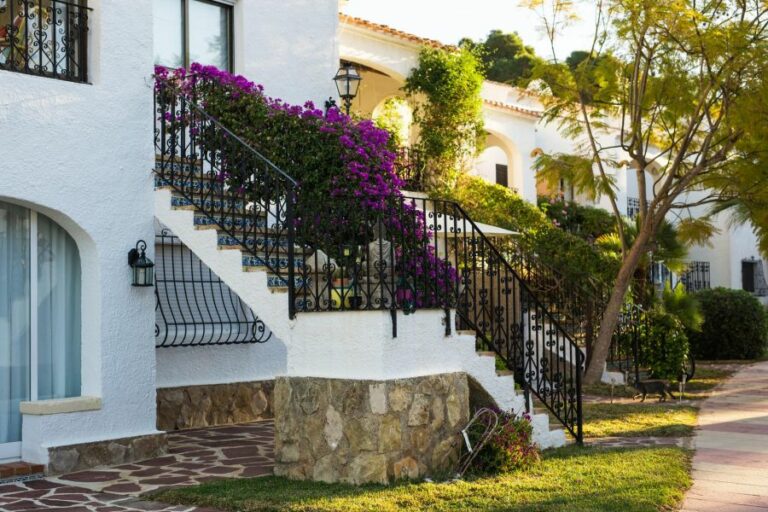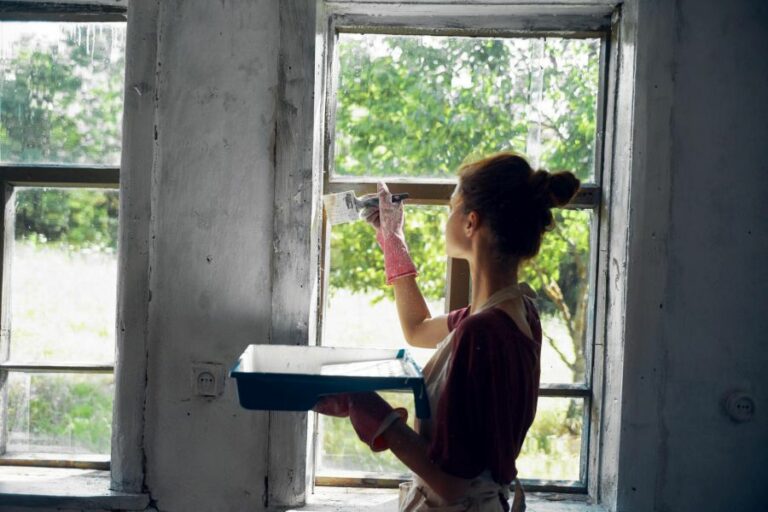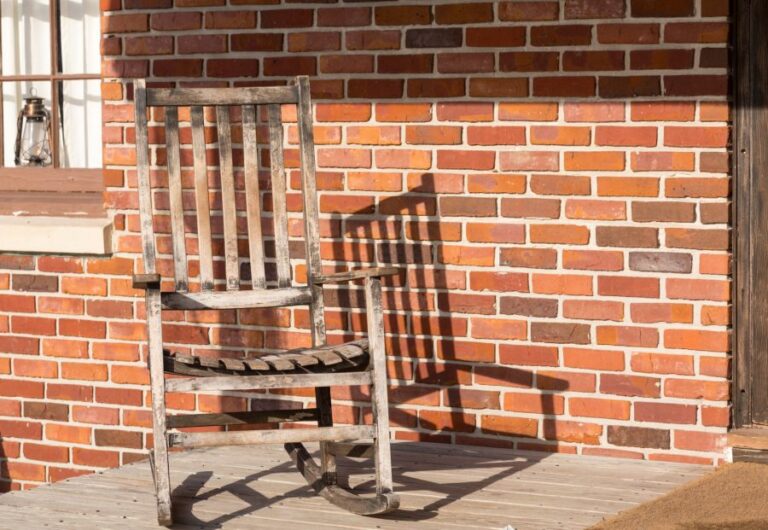Red Outdoor Paint
Choosing the right red outdoor paint can be daunting, but we are here to guide you. We’ll discuss the essential factors, such as durability, weather resistance, and color vibrancy. By the end of the conversation, you’ll be confident to select the perfect red paint to make your outdoor space look incredible and stand the test of time.
Red outdoor paint:
Red outdoor paint is a vibrant and attention-grabbing choice for exterior spaces, providing warmth and energy. Common types include acrylic, latex, oil-based paints, and exterior stains, with numerous shades available from crimson to terra-cotta. Achieve a flawless finish by properly preparing surfaces, using a primer, selecting appropriate tools, applying multiple coats, and protecting the paint job with a sealer or topcoat.

Looking to enhance the look of your outdoor space with red paint? We have more to share! Discover the best red outdoor paint options, essential tips, and tricks to achieve a long-lasting, head-turning result. Keep reading to elevate your home’s curb appeal with these exciting ideas!
Contents
- 1 Crimson Exterior Paint
- 2 Is Red an Appropriate Choice for Exterior Paint Color?
- 3 Is Red Exterior Paint Prone to Fading?
- 4 Determining the Most Suitable Paint for Exterior Painting Applications
- 5 What is the Optimal Exterior Paint for Withstanding Extreme Weather Conditions?
Crimson Exterior Paint
• Eye-Catching Hue for Exterior Spaces
Red outdoor paint is a bold and striking color option for your exterior spaces, whether you’re painting your entire house or just a door, a fence, or outdoor furniture.
This vibrant hue is known to attract attention and make a strong statement. It instantly adds warmth and energy to any outdoor space and is a classic choice for those who dare to be different.
– Types of Red Outdoor Paint
There is a wide variety of red outdoor paint options available on the market, and it’s essential to understand the different types and finishes before making a choice. Some of the most common types include:
- Acrylic paint – This water-based paint is a popular choice because it dries quickly and is resistant to chipping and peeling. It also expands and contracts with weather changes, making it less prone to cracking. Acrylic paint can be used on various outdoor surfaces, including wood, metal, and masonry.
- Latex paint – Latex paint is another water-based option that dries quickly and has lower VOCs (volatile organic compounds) compared to oil-based paints.
- Oil-based paint – This type of paint is known for its durability and long-lasting finish. It tends to be more resistant to wear and tear, making it a good option for heavily trafficked outdoor areas.
- Exterior stains – If you’re looking to enhance the natural beauty of the wood while still adding a touch of red color, an exterior stain might be the best choice. These stain options can provide a transparent or semi-transparent finish, allowing the wood grain to show through.
Picking the Perfect Shade
There are many shades of red outdoor paint to choose from, ranging from bright, true reds to darker hues with hints of brown, orange, or even purple. The right shade depends on the overall color scheme of your exterior and your personal preference.
Some popular shades of red include:
- Crimson
- Burgundy
- Brick red
- Terra-cotta
- Rose
Additionally, the Sherwin-Williams website offers a wide variety of reds to choose from, making it a helpful resource when searching for the perfect hue.
– Application Tips and Techniques
Achieving a flawless finish with red outdoor paint requires proper preparation and know-how. Follow these tips and techniques for a successful application:
Surface Preparation
To ensure a smooth, long-lasting finish, it’s essential to prepare the surface thoroughly before applying the red paint. Clean surfaces of dirt, dust, and debris, and remove any loose or flaking paint. For wood surfaces, sanding may be necessary to ensure an even surface.
Primer
Using a primer is particularly crucial when working with red paint since it tends to be more transparent than other colors. A high-quality primer will provide a suitable base for the paint, ensuring even coverage and color uniformity.
Brush or Roller
Using the right tools for your project will also have a significant impact on the final result. Brushes provide more control and are ideal for smaller, detail-oriented jobs. Roller applicators are more suitable for larger surfaces and can provide an even, smooth finish.
Multiple Coats
Due to the nature of red paint, you will likely need to apply multiple coats for a uniform and vibrant finish. Be sure to allow each coat to dry completely before applying the next one.
Protecting the Paint Job
Once you’ve achieved the desired finish, it’s essential to protect your paint job from the elements. Applying a clear sealer or quality topcoat can help preserve the color and finish of your red outdoor paint for years to come.
– In Conclusion
Red outdoor paint is a bold and captivating choice for those who want to make a statement with their exterior spaces.
By understanding the different types of paint, choosing the right shade, and following proper application techniques, you can achieve impressive results that will catch the eye and stand the test of time.
Is Red an Appropriate Choice for Exterior Paint Color?
• Introduction to Red Exterior Paint
Red is a bold and attention-grabbing color that symbolizes passion, power, and warmth. While this vibrant hue is commonly associated with feelings of love and excitement, it can also bring a sense of sophistication and classic elegance when used as an exterior paint color.
The question remains: is red a good choice for your home’s exterior?
• Energizing and Bold: The Pros of Using Red Exterior Paint
There are several reasons why you might consider using red as your home’s exterior paint color:
- Bold Aesthetic Impact: A red exterior makes a striking first impression and can significantly enhance your home’s curb appeal. This vibrant color choice can help your property stand out in the neighborhood and create a strong visual impact that attracts attention.
- Flexible Design Options: Red paint pairs well with a variety of architectural styles, from traditional to modern. It can complement various exterior materials such as brick, stucco, or siding. Red can also serve as an excellent accent color for doorways, window frames, or trim.
- Timeless Appeal: The classic elegance of red has long been associated with luxurious and sophisticated designs. Selecting a red exterior paint color can provide your home with a touch of timeless appeal that remains fresh and stylish over the years.
- Psychological Benefits: While the bold nature of red may not be suitable for everyone, for some, the color can evoke feelings of warmth, comfort, and energy. This can create an inviting atmosphere for both homeowners and guests.
• Factors to Consider When Choosing Red Exterior Paint
When considering whether red is the right exterior paint color for your home, it’s essential to keep the following factors in mind:
– Compatibility with Surroundings
Evaluate how well the color red will blend in with your natural surroundings and local architectural styles. A bright red may not fit well in a rustic or traditional setting, while a deep red could complement a more sophisticated neighborhood.
It’s also essential to consider how your home will look within the context of nearby properties. Will the color contrast dramatically against neighboring homes, or will it enhance the overall aesthetic of the area?
– Selecting the Right Shade and Tone
The specific shade and tone of red selected can make a significant difference when painting your home’s exterior. A deeper, more muted red will provide a more elegant and classic appearance, while a bright and intense red can make a bold and daring statement.
When choosing your paint color, it’s crucial to consider both your personal style preferences and how the shade will affect the look of your property.
There are several popular red hues for exterior paint, including:
- Barn Red: This traditional shade has a hint of brown that can evoke feelings of warmth and comfort. It’s an excellent choice for farmhouse-style homes or homes surrounded by natural landscapes.
- Brick Red: Inspired by the natural color of red bricks, this tone is more muted and sophisticated, making it appropriate for a wide range of architectural styles. This shade pairs well with neutral trim colors like white or cream.
- Crimson: This deep and rich shade of red can create a bold yet elegant appearance. This color is well-suited for homes with strong architectural features or historic properties.
– Understanding Maintenance Requirements
One important factor to consider when choosing red exterior paint is the potential for fading or uneven color development over time. Red pigments are more susceptible to sun damage, and the intensity of the color might fade more quickly than other hues.
Frequent touch-ups or repainting might be necessary to maintain the desired appearance.
• Final Thoughts: Is Red a Good Exterior Paint Color?
In conclusion, red can be an excellent choice for those looking to make a bold and eye-catching statement with their home’s exterior paint. This color choice can provide a unique aesthetic impact and be versatile enough to work with numerous architectural styles.
However, it’s essential to select the appropriate shade and tone of red that not only aligns with your personal preferences but also complements your home’s surroundings. Additionally, be prepared for potential maintenance requirements due to fading or uneven color development.
With these considerations in mind, if red speaks to your personal tastes and aligns with your home’s architectural style, it can undoubtedly serve as an aesthetically pleasing and impactful exterior paint color.
Is Red Exterior Paint Prone to Fading?
A common concern among homeowners and property managers is whether red exterior paint fades over time. This question has been a subject of debate for quite some time, with varying opinions on the matter.
It is essential to understand the factors that contribute to the fading of red exterior paint and explore measures to prevent or minimize this issue.
• The Science Behind Paint Fading
To comprehend why red paint may fade when applied outdoors, it’s crucial to understand the science behind paint fading. Paint fading is primarily due to the pigments used in the paint breaking down as a result of exposure to sunlight.
Sunlight consists of ultraviolet (UV) rays, which are highly energetic and can damage various materials, including the pigments in paint. The pigmentation in paint absorbs energy in the form of light and converts it into heat, which subsequently causes the pigments to deteriorate.
– Why Red Paint Fades More Quickly
The reason red paint has a reputation for fading more quickly comes down to the type of pigments used. Red pigments are more susceptible to breakdown than other colors as a result of the wavelengths of light they absorb.
Unlike other pigments, red pigments absorb every color of light except red. This means that they are exposed to a greater amount of energy from sunlight, leading to a more rapid breakdown of the pigments over time. Consequently, red paint is more prone to fading when compared to other colors.
• Factors that Contribute to Fading of Red Exterior Paint
Apart from the inherent vulnerability of red pigments, there are several other factors that contribute to the fading of red exterior paint. These factors include:
– Quality of Paint
The quality of paint plays a significant role in determining how quickly it will fade. Low-quality paints may not have the necessary UV protection or chemical stability required for exterior use. Such paints are likely to fade more quickly when exposed to sunlight.
– Amount of Pigment Used
The concentration of pigments used in the paint can also impact its susceptibility to fading. In general, higher concentrations of pigment equate to greater color retention.
However, if the concentration of pigment is too high, it might lead to the paint becoming brittle and cracking, which can also result in fading.
– Surface Preparation and Application Technique
Proper surface preparation and application techniques are crucial in determining how well the paint will adhere to the surface and how long it will last.
Poor surface preparation or application may result in uneven paint distribution, leading to a lack of protection against UV rays and a greater likelihood of fading.
– Environmental Factors
The environment in which the paint is applied plays a role in the rate at which it fades. Factors such as temperature, humidity, and exposure to pollutants can all contribute to paint fading.
In general, harsher environments with extreme temperature fluctuations, high humidity, and pollution are more likely to result in fading paint.
• Choosing the Right Paint to Minimize Fading
To reduce the risk of red exterior paint fading, opt for high-quality paint. Look for paint specifically designed for exterior use, as these are more likely to have the necessary properties required to withstand the elements, including UV protection and chemical stability.
Among exterior paints, choose those that have a 100% acrylic formula. Acrylic paints are known for their excellent color retention, durability, and resistance to fading. Additionally, consider selecting a paint with a higher concentration of pigments, as this can help to provide greater color retention over time.
• In Conclusion
While it is true that red exterior paint may fade more quickly than other colors, many factors play a role in the rate of fading.
By selecting high-quality paint that is specifically designed for exterior use, ensuring proper surface preparation and application techniques, and taking environmental factors into account, homeowners can significantly reduce the risk of fading.
Determining the Most Suitable Paint for Exterior Painting Applications
Outdoor painting, often referred to as exterior painting, is an essential aspect of protecting and beautifying your home. It not only enhances the curb appeal of your property but also provides a protective shield against various environmental factors.
Choosing the right type of paint for outdoor painting projects can make a significant difference in the durability, longevity, and appearance of your painted surfaces.
• Acrylic and Latex Paints: The Popular Choice for Most Exterior Surfaces
Acrylic and latex paints are water-based and, thus, are the most environmentally friendly choices for outdoor painting. These paints come in a wide range of finishes from flat to high-gloss and have excellent adhesion and durability.
Benefits
- They dry quickly, allowing you to apply subsequent coats in a short amount of time.
- Acrylic and latex paints are highly resistant to cracking, peeling, and blistering.
- They have remarkable color retention and resistance to fading.
- These paints are highly breathable, which means they can release moisture trapped in the substrate, reducing the potential for mold and mildew growth.
- The cleanup process after painting with acrylic or latex paint is relatively easy, requiring only soap and water.
Recommendation: Acrylic and latex paints are suitable for various outdoor surfaces, including wood, masonry, fiber cement, stucco, and aluminum siding.
Many experts agree that 100% acrylic paints provide the best performance in terms of longevity and durability compared to their latex counterparts. Always choose high-quality paint from a reputable manufacturer for the best results.
• Oil-Based Paints: A Durable Alternative
Oil-based paints, also known as alkyd paints, are another option of paint for outdoor painting projects. They contain a solvent that requires proper ventilation during application and additional drying time compared to water-based paints.
Benefits
- They offer a smooth, high-quality finish that resists chipping and peeling.
- Oil-based paints provide excellent adhesion and tend to penetrate the surface more effectively than their water-based counterparts.
- These paints have a naturally glossy finish, providing a clean and polished look to the painted surface.
- They have excellent resistance against staining and discoloration.
Drawbacks
- The drying time for oil-based paints is longer than that of latex or acrylic paints.
- They have a strong odor and require adequate ventilation during application.
- The cleanup process involves the use of harsh chemicals, such as mineral spirits or paint thinner.
- Oil-based paints are not as environmentally friendly as water-based alternatives.
Recommendation: Due to their durability and self-leveling properties, oil-based paints are best for painting metal surfaces like railings, doors, and windows. However, consult the local regulations before using oil-based paints, as their use may be restricted in certain areas due to environmental concerns.
• Choosing the Right Paint Finish
An essential aspect of choosing the best paint for outdoor painting is selecting the appropriate finish or sheen. The finish of the paint affects not just the appearance of the painted surface but also its performance and durability.
Commonly used finishes for exterior surfaces are flat/matte, satin, semi-gloss, and gloss.
Flat/Matte Finish
A flat or matte finish provides a non-reflective appearance and is ideal for masking surface imperfections. It is well-suited for large exterior wall surfaces, like stucco or masonry, as it helps hide hairline cracks and minor flaws.
Satin Finish
A satin finish is the perfect middle ground between flat and gloss finishes. It offers a subtle sheen with good durability, making it an excellent choice for siding, trim, and doors. Additionally, it is easier to clean than flat finishes and provides a more elegant appearance.
Semi-Gloss and Gloss Finish
Semi-gloss and gloss finishes are highly reflective and durable. They are perfect for areas that require frequent cleaning and maintenance, such as windows, doors, and trim work. These finishes showcase surface imperfections and require proper surface preparation before application.
Recommendation: Choose a paint finish that complements the surface you are painting and meets your aesthetic preferences and maintenance requirements. A combination of finishes on different surfaces can create visual interest and enhance the overall appearance of your property.
• Conclusion
There isn’t a one-size-fits-all answer to the question of which paint is the best for outdoor painting. The right paint for your exterior painting project depends on the surface you will be painting, local climate conditions, and your preferred finish.
As a rule of thumb, choose high-quality acrylic or latex paints for most outdoor surfaces and opt for oil-based paints for metal surfaces. Don’t forget to invest time in surface preparation, as it can significantly affect the final result and the longevity of your paint job.
Paint Type | Pros | Cons |
|---|---|---|
Acrylic Latex | Water-based, easy to clean, dries quickly, UV resistant | Not ideal for highly porous surfaces, may not last as long on rough surfaces |
Oil-Based | Durable, long-lasting, resists chipping and wear | Longer drying time, hard to clean, can be harmful to the environment |
100% Acrylic | Highly durable, excellent adhesion, resistant to fading and chalking, great for a variety of surfaces | More expensive than other paints, but worth the investment for outdoor painting |
What is the Optimal Exterior Paint for Withstanding Extreme Weather Conditions?
When it comes to painting the exterior of your home, choosing the right paint is a critical decision. In areas with extreme weather conditions – such as intense heat, cold, rain, hail, or high winds – making the right choice becomes even more important.
• The Importance of Quality Paints in Extreme Weather
It’s essential to understand the factors that make the paint more resistant to extreme weather conditions. Some key characteristics of a high-quality exterior paint include:
- UV resistance: Protection from the sun’s harmful ultraviolet rays is especially important in areas with intense heat or long periods of sun exposure.
- Water resistance: A high-quality paint should form a protective barrier against moisture, preventing it from seeping into the surface underneath.
- Breathability: Paints that allow the surface to breathe help prevent issues like peeling or blistering when there is a difference in temperature or humidity between the inside and outside of the building.
- Flexibility: Good-quality paints can expand and contract along with the surface they are applied to, reducing the likelihood of cracking or peeling in fluctuating temperatures.
- Adhesion: Strong adhesion to the surface is important in ensuring that the paint lasts in spite of harsh conditions, such as high winds or heavy rain.
Now that we have a better understanding of the key features to look for in a quality exterior paint, let’s discuss some of the top paint options for extreme weather conditions.
• Top Exterior Paints for Extreme Weather Conditions
1. Sherwin-Williams Duration Exterior Acrylic Latex
Sherwin-Williams Duration Exterior Acrylic Latex is a highly durable paint that offers excellent resistance to weathering and dirt pick-up. It is a self-priming paint, which means you can save time and money by skipping the primer coat.
The paint is formulated with PermaLast Technology, providing superior adhesion and flexibility. This ensures that the paint can withstand harsh weather conditions without cracking or peeling.
I recommend this paint for areas with intense sun exposure or fluctuating temperatures, as it provides great UV resistance and flexibility.
2. Benjamin Moore Aura Exterior Paint
Benjamin Moore Aura Exterior Paint (source) is known for its excellent durability and resistance to fading, cracking, or peeling. This paint uses Color Lock Technology, which ensures that the paint’s color remains vibrant even under the harshest conditions.
It is also formulated to be mildew-resistant, an important factor for homes in areas with high humidity or heavy rainfall.
I recommend this paint for homeowners who prioritize color retention and protection against mildew.
– 3. PPG Timeless Exterior Paint and Primer
PPG Timeless Exterior Paint and Primer boasts a unique formula that provides one-coat coverage in a variety of weather conditions.
This paint is formulated with UV-protective components to guard against sun damage and maintain color over time. It also offers excellent resistance to chalking, a common issue in areas with intense sun exposure.
I recommend this paint for those who want a one-coat solution that provides exceptional protection against extreme weather.
4. Behr Marquee Exterior Paint and Primer
Behr Marquee Exterior Paint and Primer is specifically designed for extreme weather conditions, with features that provide excellent dirt and fade resistance.
This paint also offers a one-coat hide system, which saves time and effort when painting your home’s exterior. Its mildew-resistant finish makes it a great option for homes in humid or rainy environments.
I recommend this paint for those wanting a long-lasting paint solution that requires minimal maintenance.
• Choosing the Right Paint for Your Home
When selecting the best exterior paint for your home in extreme weather conditions, it’s crucial to consider factors such as UV protection, water resistance, breathability, flexibility, and adhesion.
The above-listed paint options offer a range of features designed to handle the toughest weather conditions, but it’s essential to look at the particular needs of your home and location to make the best choice.
Remember that proper surface preparation, priming (if necessary), and application according to the manufacturer’s guidelines will also have a significant impact on the paint’s durability and longevity.
Be sure to invest in quality materials and take the time to do the job right. It will be well worth it in the long run.
By choosing a high-quality paint that is specifically designed for extreme weather conditions, you can enjoy the benefits of a beautiful, long-lasting finish that will protect your home for years to come.







